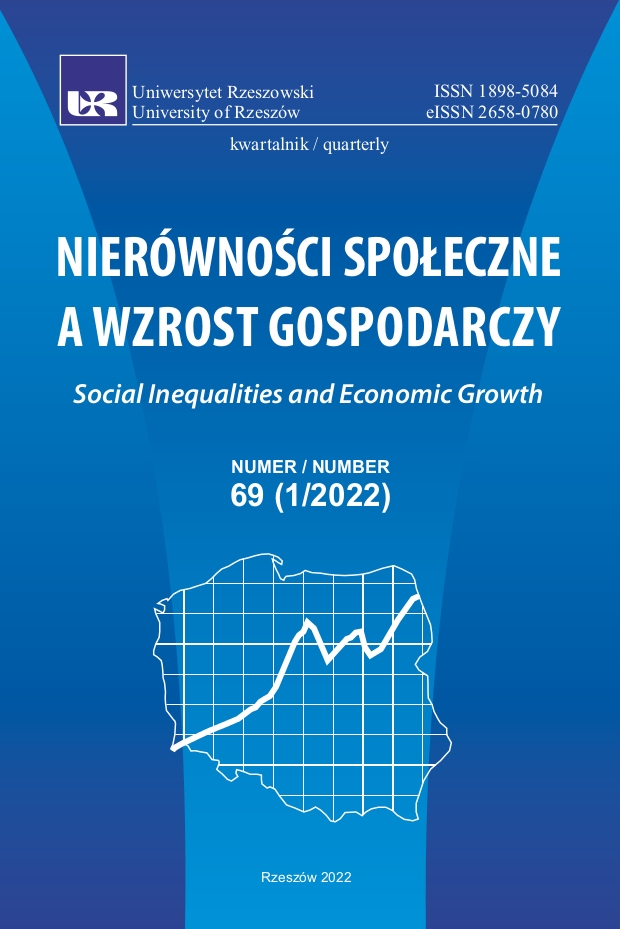Bariery i możliwości rozwoju e-commerce z perspektywy „Pokolenia Z” z Polski i Albanii
DOI:
https://doi.org/10.15584/nsawg.2022.1.5Słowa kluczowe:
e-commerce, młodzi ludzie, Internet, możliwości rozwoju, bariery i korzyściAbstrakt
Celem pracy jest identyfikacja wyzwań stojących przed branżą e-commerce, a także wskazanie barier i możliwości rozwoju tego sektora z perspektywy młodych ludzi. Z analizy raportów analizowanych w pracy wynika, iż zarówno w Polsce, jak i w Albanii, nastąpił w ostatnich kilku latach gwałtowny wzrost liczby oraz wartości firm z branży e-commerce. Badania własne przeprowadzono w grupie studentów kierunków ekonomia i zarządzanie na Uniwersytecie Rolniczym w Krakowie (Polska) oraz na Uniwersytecie im. Aleksandër Moisiu w Durres (Albania). Badania ankietowe miały na celu pozyskanie opinii młodych ludzi dotyczących zakupów online z punktu widzenia klienta, a także opinii dotyczącej prowadzenia własnej firmy w obszarze e-commerce. Łącznie uzyskano 145 odpowiedzi ankietowych. Respondenci z obu krajów wskazali wiele korzyści prowadzenia e-firmy, w tym przede wszystkim wygodę i niższe koszty działalności. Ta forma prowadzenia biznesu jest dla wielu ludzi z tzw. „Pokolenia Z” bardzo kusząca. Ankietowani dostrzegają jednak pewne ograniczenia. Najważniejsza według nich bariera to duża konkurencja, a także brak innowacyjnych pomysłów, które pozwoliłyby przebić się na rynku. Jeśli chodzi o Albanię, istotnym problemem jest nadal niedoskonała infrastruktura techniczna i technologiczna oraz niski poziom zaufania konsumentów do tego typu transakcji (np. brak ochrony prawnej kupujących w sieci). Innym niezmiernie istotnym aspektem, wskazanym przez obie grupy ankietowanych, jest wiedza na temat prowadzenia biznesu w sieci. Dlatego też, biorąc po uwagę prognozy rozwoju e-commerce dla Polski i Albanii, istnieje potrzeba dostarczania aktualnej wiedzy i informacji z obszaru zakładania i prowadzenia e-biznesu. Potrzebni są eksperci w tej dziedzinie, a także wykwalifikowana kadra nauczycielska i akademicka.
Downloads
Bibliografia
Albania E-commerce Diagnostic. Leveraging the Digital Trade Opportunity. World Bank Group. 2020 International Bank for Reconstruction and Development. Retrieved from: http://www.openknowledge.worldbank.org (2021.06.25).
Bilan, K. (2021). 300%, czyli pełna moc e-sklepu. Forbes Magazine, 6, 149.
Chaffey, D. (2007). E-business and E-commerce Management: Strategy, Implementation and Practice. England: Prentice Hall.
Damanpour, F., Damanpour, J. A. (2001). Ebusiness ecommerce evolution: perspective and strategy. Managerial Finance, 27(7), 16–33. DOI: 10.1108/03074350110767268.
E-commerce w Polsce 2020. Gemius dla E-commerce Polska. Retrieved from: http://www.gemius.pl (2021.08.06).
Daniel, E., Wilson, H. (2002). Adoption intentions and benefits realised: a study of e‐commerce in UK SMEs. Journal of Small Business and Enterprise Development, 9(4), 331–348. DOI: 10.1108/14626000210450522.
Dobosz, K. (2012). Handel elektroniczny. Warszawa: Polsko-Japońska Wyższa Szkoła Technik Komputerowych.
Dobroszek, K. (2021). Biec z wiatrem: najlepsze startupy e-commerce. MyCompany Magazine 6(69), 72–75.
Gregor, B., Stawiszyński, M. (2002). E-commerce. Bydgoszcz-Łódź: Oficyna Wydawnicza Branta.
Kaptein, M., Parvinen, P. (2015). Advancing E-Commerce Personalization: Process Framework and Case Study. International Journal of Electronic Commerce, 19(3), 7–33. DOI: 10.1080/10864415.2015.1000216.
Kowalik, F. (2021). Internet znów uwodzi inwestorów. Forbes, 6, 56–58.
Laudon, K. C., Traver, C. G. (2020). E-Commerce 2019: Business, Technology, and Society. Pearson, 16th Edition. Electronic Book.
Norris, M., West, S. (2001). E-biznes. Warszawa: Wydawnictwa Komunikacji i Łączności.
Mohapatra, S. (2013). E-Commerce Strategy. In: E-Commerce Strategy. Springer Texts in Business and Economics (pp. 155–171). Boston: Springer. DOI: 10.1007/978-1-4614-4142-7_7.
Molla, A., Heeks, R. (2007). Exploring E-Commerce Benefits for Businesses in a Developing Country. The Information Society, 23(2), 95–108. DOI: 10.1080/01972240701224028.
Rodgers, J. A., Yen, D. C., Chou, D. C. (2002). Developing e-business: a strategic approach. Information Management & Computer Security, 10(4), 184–192. DOI: 10.1108/09685220210436985.
Rogers, C. (2014). Digital Skills and Motivation in Young People in Transition. In: D. Passey, A. Tatnall (eds.), Key competencies in ICT and Informatics. Implications and Issues for Educational Professionals and Management (pp. 150–164). IFIP Advances in Information and Communication Technology, 444. Berlin, Heidelberg: Springer. DOI:10.1007/978-3-662-45770-2_14.
Sanwal, T., Avasthi, S., Saxena, S. (2016). E-Commerce and its sway on the minds of young generation. International Journal of Scientific and Research Publications, 6(3), 112–117.
Szpringer, W. (2000). Handel elektroniczny: konkurencja czy regulacja? Warszawa: Wydawnictwo Difin.
The World Bank Enterprise Survey. Retrieved from: http://www.enterprisesurveys.org(2021.07.19).
The World Bank Findex Data. Retrieved from: http://www.globalfindex.worldbank.org(2021.07.26)
Vieira J., Frade R., Ascenso R., Prates, I., Martinho, F. (2020). Generation Z and KeyFactors on E-Commerce: A Study on the Portuguese Tourism Sector. Administrative Sciences, 10(4), 103, 1–17. DOI: 10.3390/admsci10040103.
Pobrania
Opublikowane
Jak cytować
Numer
Dział
Licencja

Utwór dostępny jest na licencji Creative Commons Uznanie autorstwa – Na tych samych warunkach 4.0 Miedzynarodowe.


